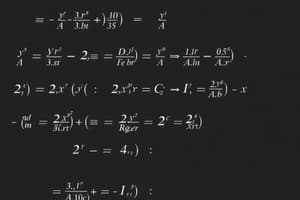Podcast
Questions and Answers
What was the direct consequence of the British Parliament passing a new act in 1858 regarding the East India Company?
What was the direct consequence of the British Parliament passing a new act in 1858 regarding the East India Company?
- It led to the immediate dissolution of the East India Company and the establishment of independent Indian rule.
- It transferred the powers of the East India Company to the British Crown to ensure responsible management of Indian affairs. (correct)
- It allowed the Company to operate autonomously, free from British governmental oversight.
- It ensured the Company's continued governance with enhanced powers.
What was a significant measure taken by the British government following the transfer of power from the East India Company?
What was a significant measure taken by the British government following the transfer of power from the East India Company?
- Appointing a Secretary of State for India, making them responsible for matters related to the governance of India. (correct)
- Abolishing the position of Governor-General.
- Establishing a council of Indian representatives to oversee British policies.
- Granting complete autonomy to local Indian rulers.
What title was bestowed upon the Governor-General after the British government accepted direct responsibility for ruling India?
What title was bestowed upon the Governor-General after the British government accepted direct responsibility for ruling India?
- The Prime Minister of India
- The President of the Indian Council
- The Emperor of India
- The Viceroy, as a personal representative of the Crown (correct)
Following the quelling of the 1857 revolt, what action did the British take regarding those who had rebelled, conditional upon the rebels submitting to their authority?
Following the quelling of the 1857 revolt, what action did the British take regarding those who had rebelled, conditional upon the rebels submitting to their authority?
What significant change was made in the British army's recruitment strategy after the 1857 revolt?
What significant change was made in the British army's recruitment strategy after the 1857 revolt?
What assurance was given to all ruling chiefs of the country by the British to ensure their loyalty?
What assurance was given to all ruling chiefs of the country by the British to ensure their loyalty?
How did the British propose to handle the land and property of Muslims after the 1857 revolt?
How did the British propose to handle the land and property of Muslims after the 1857 revolt?
After 1857, how did the British decide to approach the customary religious and social practices of the people in India?
After 1857, how did the British decide to approach the customary religious and social practices of the people in India?
Following the 1857 revolt in India, what was the primary aim of the policies made by the British regarding landlords and zamindars?
Following the 1857 revolt in India, what was the primary aim of the policies made by the British regarding landlords and zamindars?
How did the British forces ultimately suppress the widespread popular rebellion of 1857?
How did the British forces ultimately suppress the widespread popular rebellion of 1857?
Despite the recapture of Delhi by the British, what challenge persisted in the aftermath of the initial victory?
Despite the recapture of Delhi by the British, what challenge persisted in the aftermath of the initial victory?
In March 1858, which significant event marked a setback for the rebel forces in a key region?
In March 1858, which significant event marked a setback for the rebel forces in a key region?
Who embraced death when surrounded by the British on all sides after initial victories?
Who embraced death when surrounded by the British on all sides after initial victories?
What strategy did Tantia Tope adopt to continue the fight against the British after setbacks in key battles?
What strategy did Tantia Tope adopt to continue the fight against the British after setbacks in key battles?
What impact did victories against the British initially have on the rebel forces during the 1857 revolt?
What impact did victories against the British initially have on the rebel forces during the 1857 revolt?
How did the British attempt to undermine the loyalty of the general populace towards the rebel cause?
How did the British attempt to undermine the loyalty of the general populace towards the rebel cause?
What condition was placed on those who had rebelled against the British to avoid severe punishment, besides showing submission?
What condition was placed on those who had rebelled against the British to avoid severe punishment, besides showing submission?
After suppressing the 1857 revolt, British passed a new laws so that, under what circumstances could the rebels be convicted?
After suppressing the 1857 revolt, British passed a new laws so that, under what circumstances could the rebels be convicted?
What was the eventual fate of Bahadur Shah Zafar, the last Mughal emperor, following the recapture of Delhi?
What was the eventual fate of Bahadur Shah Zafar, the last Mughal emperor, following the recapture of Delhi?
How did the British respond to the resentment of high taxes and rigid revenue collection methods among the peasants and zamindars?
How did the British respond to the resentment of high taxes and rigid revenue collection methods among the peasants and zamindars?
Flashcards
Nawabs Lost Power
Nawabs Lost Power
Nawabs and rajas lost their authority and honor.
British Beliefs
British Beliefs
The British believed Indian society needed reform.
Peasant Grievances
Peasant Grievances
The peasants and zamindars face high taxes and rigid collection.
Define Mutiny
Define Mutiny
Signup and view all the flashcards
1857 Sepoy Mutiny
1857 Sepoy Mutiny
Signup and view all the flashcards
Who was Mangal Pandey?
Who was Mangal Pandey?
Signup and view all the flashcards
Meerut to Delhi
Meerut to Delhi
Signup and view all the flashcards
What are Firangis?
What are Firangis?
Signup and view all the flashcards
Rebellion Spreads
Rebellion Spreads
Signup and view all the flashcards
Company Fights Back
Company Fights Back
Signup and view all the flashcards
Reinforcements from England
Reinforcements from England
Signup and view all the flashcards
Delhi Recaptured
Delhi Recaptured
Signup and view all the flashcards
Bahadur Shah Zafar Demise
Bahadur Shah Zafar Demise
Signup and view all the flashcards
After the British would reward
After the British would reward
Signup and view all the flashcards
Study Notes
Funciones Vectoriales de Variable Real
- A function that maps real numbers to vectors in $\mathbb{R}^n$.
- Denoted as $\overrightarrow{r}: \mathbb{R} \rightarrow \mathbb{R}^n$.
Componentes
- Vector functions can be expressed in terms of component functions: $\overrightarrow{r}(t) = \langle f_1(t), f_2(t), \dots, f_n(t) \rangle$.
- $f_i(t)$ are real functions of the real variable $t$.
Límite
- The limit of $\overrightarrow{r}(t)$ as $t$ approaches $a$ is a vector: $\lim_{t \to a} \overrightarrow{r}(t) = \langle \lim_{t \to a} f_1(t), \lim_{t \to a} f_2(t), \dots, \lim_{t \to a} f_n(t) \rangle$.
- Exists if each component function's limit exists.
Continuidad
A vector function $\overrightarrow{r}(t)$ is continuous at $t=a$ if:
- $\overrightarrow{r}(a)$ is defined.
- $\lim_{t \to a} \overrightarrow{r}(t)$ exists.
- $\lim_{t \to a} \overrightarrow{r}(t) = \overrightarrow{r}(a)$.
Derivada
- Derivative of $\overrightarrow{r}(t)$ is defined as $\overrightarrow{r}'(t) = \lim_{h \to 0} \frac{\overrightarrow{r}(t + h) - \overrightarrow{r}(t)}{h}$.
- Equivalently, $\overrightarrow{r}'(t) = \langle f_1'(t), f_2'(t), \dots, f_n'(t) \rangle$.
Integral
- Integral of $\overrightarrow{r}(t)$ is found component-wise: $\int \overrightarrow{r}(t) dt = \langle \int f_1(t) dt, \int f_2(t) dt, \dots, \int f_n(t) dt \rangle + \overrightarrow{C}$.
- $\overrightarrow{C}$ is a constant vector of integration.
Interpretación Geométrica
- $\overrightarrow{r}(t)$ traces a curve in space as $t$ varies.
- $\overrightarrow{r}'(t)$ is tangent to the curve at $\overrightarrow{r}(t)$, indicating instantaneous direction.
The Scientific Method
- A structured approach to scientific inquiry.
The Six Steps
- Step 1: Ask a Question
- Step 2: Do Background Research
- Step 3: Construct a Hypothesis
- Step 4: Test Your Hypothesis by Doing an Experiment
- Step 5: Analyze Your Data and Draw a Conclusion
- Step 6: Communicate Your Results
Vocabulary
- Hypothesis: An educated guess about how things work.
- Theory: A hypothesis tested with a significant amount of data.
- Law: A proven theory.
- Control Group: Does not receive experimental treatment in an experiment.
- Independent Variable: Deliberately changed variable.
- Dependent Variable: Measured variable.
1. 2 Exponential Functions
Exponential Functions
- For all real numbers $x$, the exponential function with base $a$ is $f(x) = a^x$.
- Applies where $a > 0$ and $a \neq 1$.
- Examples: $f(x) = 3^x$, $g(x) = 10^x$, $h(x) = (\frac{1}{2})^x$.
Graph of Exponential Functions
- Case 1: If $a > 1$, $f(x) = a^x$ is an increasing function with $\lim_{x \to -\infty} a^x = 0$ and $\lim_{x \to \infty} a^x = \infty$.
- Case 2: If $0 < a < 1$, $f(x) = a^x$ is a decreasing function with $\lim_{x \to -\infty} a^x = \infty$ and $\lim_{x \to \infty} a^x = 0$.
Algorithmic Trading
- Definition: Automated execution of orders using pre-programmed instructions.
- Variables: Price, timing and volume.
- Other Names: Automated trading, black-box trading, algo-trading.
How it Works
- Algorithm Development: Convert a trading strategy into computer code.
- Testing: Conduct back-testing using historical data.
- Execution: Algorithm is deployed on trading platforms.
- Monitoring: Continuous monitoring and adjustments.
Advantages
- Speed & Efficiency: Execute trades faster than humans.
- Reduced Emotional Bias: Removes emotional influence.
- Backtesting: Evaluate with historical data.
- Diversification: Ability to trade across markets and instruments.
- Cost Reduction: Lowers transaction costs.
- Improved Order Execution: Execute sizable orders without impacting market prices.
Disadvantages
- Technical Issues: System or connectivity failures.
- Over-Optimization: Poor live trading results from optimization based on historical data.
- Market Volatility: Algorithms may perform poorly.
- Monitoring & Maintenance: Requires ongoing monitoring and adjustments.
- Complexity: Sophisticated algorithms necessitate specific skills.
Types of Algorithmic Trading Strategies
- Trend Following: Capitalize on existing market trends (e.g., moving averages, MACD).
- Mean Reversion: Capitalize on prices reverting to average value (e.g., Bollinger Bands, RSI).
- Arbitrage: Exploit price differences in different markets (e.g., triangular, statistical arbitrage).
- Market Making: Provide liquidity by placing buy/sell orders, capturing bid/ask spread (e.g., HFT firms).
- Statistical Arbitrage: Use statistical models to identify pricing anomalies (e.g., pairs trading, factor models).
- Execution Algorithms: Optimize execution of large orders (e.g., TWAP, VWAP).
Tools and Technologies
- Programming Languages: Python, Java, C++.
- Trading Platforms: MetaTrader, TradingView.
- Data Feeds: Bloomberg, Reuters.
- Libraries: Pandas, NumPy, SciKit-Learn.
Skills Required
- Programming: Expertise in languages like Python, Java, or C++.
- Financial Knowledge: Understand financial market.
- Mathematics & Statistics: Essential for statistical analysis.
- Data Analysis: Analyze and interpret large datasets.
- Risk Management: Mitigate risks associated with trading.
Machine Learning: Unsupervised Learning
- Focuses on Clustering, involving grouping data without prior labels.
Types of Clustering
- Partitioning Clustering: Divides data into non-overlapping subsets.
- Examples: k-means, k-medoids.
- Hierarchical Clustering: Creates a tree-like structure of clusters.
- Types: Agglomerative (bottom-up) and Divisive (top-down).
- Density-based Clustering: Identifies clusters as dense regions.
- Examples: DBSCAN, OPTICS.
K-Means
- Algorithm:
- Choose the number of clusters $K$.
- Randomly initialize $K$ cluster centroids.
- Assign each data point to nearest centroid based on distance.
- Recalculate the centroids of the clusters.
- Repeat steps until convergence.
- Objective Function: Minimize Within-Cluster Sum of Squares (WCSS).
Choosing Optimal K
- Elbow Method: Plot WCSS for different $K$ values.
- Silhouette Score: Measures similarity within one's own cluster.
Pros
- Simple to implement
- Efficient for large datasets.
Cons
- Sensitive to initial centroid positions.
- Assumes clusters are spherical and equally sized.
- Requires specifying $K$ in advance.
Hierarchical Clustering
- Types:
- Agglomerative (Bottom-Up): Start with each data point as a cluster, merge until one remains.
- Divisive (Top-Down): Start with all data points in one cluster, divide into smaller ones.
- Dendrogram: Tree-like diagram showing the hierarchy.
Choosing Number of Clusters
- Cut the dendrogram at the desired level.
Pros
- Does not require $K$ in advance.
- Provides cluster hierarchy.
Cons
- Computationally expensive.
- Sensitive to noise and outliers.
DBSCAN (Density-Based Spatial Clustering of Applications with Noise)
- Parameters:
- Eps (ε): Radius to search for neighbors.
- MinPts: Minimum points within $\epsilon$ radius to consider an area dense.
- Point Types:
- Core Point: At least MinPts neighbors within Eps radius.
- Border Point: Not a core point, but has one within Eps radius.
- Noise Point: Neither core nor border point.
- Algorithm:
- Start with a data point and retrieve neighbors within Eps radius.
- If enough neighbors, it's a core point, and a new cluster is formed.
Pros
- Does not require specifying the number of Clusters
- Does arbitrary shapes
- Robust to Outliers
Cons
- Sensitive to Parameter Setting
- May have difficulty with varying densities due to parameters
Evaluation Metrics
- Silhouette Score: ratio between distace between clusters, intra-cluster
- Davies-Bouldin Index: σ_i = average distance
- Calinski-Harabasz Index: ratio of between cluster variance
Economics
- The study of how societies use scarce resources to produce valuable goods and services.
- Studies how these resources are used among individuals.
Tow Key ideas
- Resources are scarce
- The society should use the resources in an efficient manner
Microeconomics
- The study about particular, individual components
- such as industries, companies and housholds.
Macroeconomics
- The study about an economy's general operation,
- GDP, Interest Rates, Jobs, Inflation
Three Fundamental Questions:
- what goods and services are produced
- how are the goods produced
- for whom are the goods made for
Economic Systems:
- Market: Decisions are made in markets between individuals/businesses normally through exchanges of money.
- Planned: Decisions are made by a central authority, employees are directed by the government
- Mixed: Elements of market and planned economies
Technological Possibilities of Society:
- Inputs such as are used to produce outputs
- A PPF shows the maximum amount of goods and service that an ecomony can produce
Opportunity cost:
- the cost of a decision is given by the next best alternative opportunity
- Productive efficiency:
- when an economy cannot produce more of one, without producing less of the other
- meaning an economy is on the PPF
Lecture 4. 1: Concept of Limit of a Function
Intuitive Idea
- Consider the function f(x)=(x^2-1)/(x-1)
- The Funtion is not defined at x=1
- What happens to the values as x approaches 1
Lecture 16
Numerical Integration
- Newcon-Cotes Integration Formula
- Uses function values at equaly spaced points
- Constructed to integrate polynomials of degree n exactly, where n+1 number of points
Basic Numerical Formulas
- Midpoint rule
- Trapezoid Rule
- Simpson's Rule
Composite Numerical Integration
- Divide (a,b) into n subintervals of length h
Studying That Suits You
Use AI to generate personalized quizzes and flashcards to suit your learning preferences.



